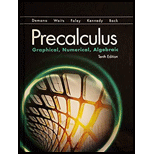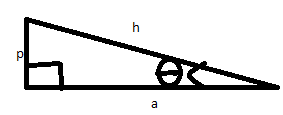
To identify: Which column gives sine values, which gives cosine values, and which gives tangent values without using a calculator. Below is a simplified trig table for angles between 40° and 50°.
Column 1 represents tangent, column 2 represents sine and column 3 represents cosine.
Given information:
The given table is:
Explanation:
Consider the given information.
The first two columns have numbers that increase as the angle increases. This is because when making the angle bigger, the opposite side will also get bigger.

The first column represents the tangent because the value of cosine and sine both lies between
Since the first column has value greater than 1 so it must be tangent.
The value of
Here it can be observed that this is happing in column 2.
Also, the value of
Here it can be observed that this is happing in column 3.
With cosine, as the angle gets bigger, the adjacent side gets smaller. This makes sense if you picture stretching the triangle up and down. The opposite side will get bigger, but the adjacent will get smaller.
Thus, Column 1 represents tangent, column 2 represents sine and column 3 represents cosine.
Chapter 4 Solutions
EBK PRECALCULUS:GRAPHICAL,...-NASTA ED.
 Calculus: Early TranscendentalsCalculusISBN:9781285741550Author:James StewartPublisher:Cengage Learning
Calculus: Early TranscendentalsCalculusISBN:9781285741550Author:James StewartPublisher:Cengage Learning Thomas' Calculus (14th Edition)CalculusISBN:9780134438986Author:Joel R. Hass, Christopher E. Heil, Maurice D. WeirPublisher:PEARSON
Thomas' Calculus (14th Edition)CalculusISBN:9780134438986Author:Joel R. Hass, Christopher E. Heil, Maurice D. WeirPublisher:PEARSON Calculus: Early Transcendentals (3rd Edition)CalculusISBN:9780134763644Author:William L. Briggs, Lyle Cochran, Bernard Gillett, Eric SchulzPublisher:PEARSON
Calculus: Early Transcendentals (3rd Edition)CalculusISBN:9780134763644Author:William L. Briggs, Lyle Cochran, Bernard Gillett, Eric SchulzPublisher:PEARSON Calculus: Early TranscendentalsCalculusISBN:9781319050740Author:Jon Rogawski, Colin Adams, Robert FranzosaPublisher:W. H. Freeman
Calculus: Early TranscendentalsCalculusISBN:9781319050740Author:Jon Rogawski, Colin Adams, Robert FranzosaPublisher:W. H. Freeman
 Calculus: Early Transcendental FunctionsCalculusISBN:9781337552516Author:Ron Larson, Bruce H. EdwardsPublisher:Cengage Learning
Calculus: Early Transcendental FunctionsCalculusISBN:9781337552516Author:Ron Larson, Bruce H. EdwardsPublisher:Cengage Learning





